Volunteers for the Officer Corps
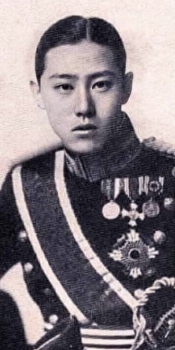
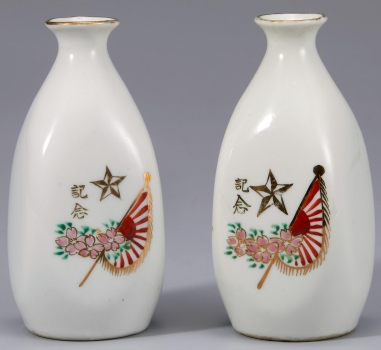
On the front is the inscription 記念 meaning Commemorative. On the backside is a three line inscription: 朝鮮龍山步兵 Chosŏn Yongsan Infantry, 第七十八聯隊 Seventy-eighth Regiment, and 堀田長雄 – Nagao Hotta who was the man who ordered the Tokkuri and a set of sake cups (as a gift for friends and relatives).
Picture source: Yongsan History Museum
Before the Annexation of Korea in 1910, officer volunteers from Korea had been joining the Imperial Japanese Army Academy 륙군사관학교 (陸軍士官学校) located in Ichigaya, Tokyo. Several Korean graduates of the Army Academy rose to the upper ranks of the Japanese military and served during World War II. The vast majority of these volunteers were upper-echelon family members who had the approval of the Korean Empire. Some of those graduates are:
- Lieutenant General Yi Un 이은 (李垠)(Crown Prince of Korea, Son of Emperor Kojong)
- Lieutenant General Jo Seong-geun 조성근 (趙性根)
- Lieutenant General (Viscount) Yi Beyong-mu 이병무 (李秉武)
- Lieutenant General Hong Sa-ik 홍사익 (洪思翊) (Executed after WWII for war crimes)
- Lieutenant General Kim Suk-won 김석원 (金錫源) (Became a Major General in the South Korean Army after World War II)
- Major General Kim Eung-seon 김응선 (金應善) (Military aide and personal guard to Prince Yi Un)
- Major General Wang Yu-shik 왕유식 (王瑜植)
- Major General Yi Hee-du 이희두 (李熙斗) (Died in 1925 and did not serve in World War II)
- Colonel Yi U 이우 (李鍝) (Prince, Grandson of Emperor Kojong) He was killed at Hiroshima by the atomic bomb. Two days later, after the funeral for the prince, his adjutant, Lieutenant Colonel Yoshinari Hiroshi (吉成 弘) committed seppuku (ritual suicide) for failing to adequately protect Prince Yi.1
After the annexation of Korea, it was legal for a young Korean to become an officer in the Imperial Japanese Army, but no legal channels existed for doing so. It wasn’t until 1925 that Koreans could actually apply for admission to the preparatory school of the Japanese Army. From then until 1928, there were Korean applicants every year, but not a single Korean was accepted.
In 1932, the Japanese established the puppet regime of Manchukuo in Northern China. To provide the Manchukuo Imperial Army with more reliable troops, military Academies 만주국신경륙군군관학교 (滿洲國新京陸軍軍官學校) were established in Mukden 奉天 and in the capital of Hsinking 新京. Attending the Imperial Japanese Army Academy in Japan was impossible without the right connections, so a number of ethnic Koreans saw the Manchukuo military academies as their only opportunity for a military career. Among the Manchukuo Army Academy graduates were South Korean Generals Paik Sun-yup 백선엽 (白善燁, 1920 – 2020), and Chung Il-kwon 정일권 (丁一權, 1917 – 1994). The future President of South Korea, Park Chung-hee 박정희 (朴正熙, 1917 – 1979) was also a graduate of the Manchukuo Imperial Army Academy.
Volunteers for the Enlisted Ranks
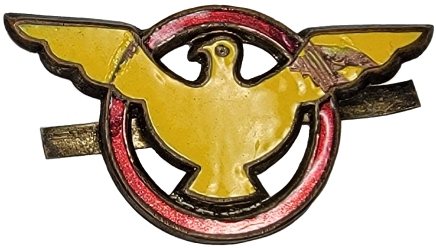
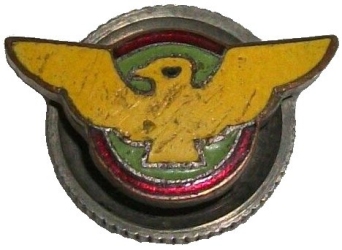
In 1938, the Japanese Empire launched the National Spiritual Mobilization Movement 國民精神総動員運動, and on September 22 of that year, the Korean Federation 朝鮮聯盟 for National Spiritual Mobilization was formed to support the expropriation of human and material resources. The National Spiritual Mobilization Federation established a wartime system through cooperation on the national policy of the Japanese during wartime, as well as the nationalization of the Korean people and the unification of internal affairs. In 1940, the Chosŏn Federation for National Mobilization was expanded to become the All-In-One Chosŏn Federation.
In the early stages of the Second Sino-Japanese War (1937-1945), the Governor General in Korea (GGK) limited Koreans to labor roles supporting the war. The recruitment of Enlisted Soldiers did not begin until Feb. 22, 1938, when the GGK announced that Korean men could apply for service in the Japanese Imperial Army through the Korean Special Volunteer Soldier System 육군특별지원병제도.2 This was followed, 4 years later, when the GGK announced the Korean Student Special Volunteer Soldier System 학도 특별지원병 제도. In May 1943, the GGK announced the creation of the Naval Special Volunteer Soldier System 해군 특별지원병 제도.
The acceptance rate of volunteers into the Japanese Army was 14% in 1938 but dropped to a 2% acceptance rate in 1943 while the yearly number of applicants increased over the same time span (See the chart to the right). On average, only 2.2% of applicants were accepted into the Army. While these systems were allegedly “Volunteer”, it is estimated that only 35% of all applicants were actual volunteers. The Japanese, to save face, coerced the majority of applicants or simply doctored the books. The primary reason that enticed young Koreans to apply to the Japanese army was the extreme poverty faced by the peasants. There are estimates that more than 90% of those who actually did “Volunteer” came from peasant families. Other special enticements were also given, which included promises that volunteers were to receive priority for police officer and civil servant jobs as well as other leadership positions, after being honorably discharged from the military. In 1938, volunteers had to submit five types of documents: “Applicant Training Camp Admission Application”, “Resume”, “Asset and Income Statements with Certifications”, and a “Physical Fitness Test Sheet”. In 1940, the Governor General of Korea (GGK) 조선총독 (朝鮮総督) lowered the height and educational requirements. They also reduced the number of documents required to volunteer. The “Asset and Income Statements with Certifications” were deleted. One has to ask if there was such an excess of volunteers, why did the GGK lower the standards?
Volunteers for the Japanese Imperial Navy were subjected to much higher loyalty standards than the Army because it only takes 1 man to scuttle a ship.
It would appear that the Golden Kite 金鵄 (Hawk) superimposed over a Red Circle was used exclusively in Korea. Golden Kites were used on other Japanese medals and badges, but without the red circle, often with a solid red disc or sun shape behind the bird. The Golden Kites with outstretched wings was a Japanese military symbol and comes from a legend where a golden kite came from the gods and assisted the mythical Emperor Jimmu 神武天皇 in battle. The legend of Jimmu is probably a mixture of myth with some plausible history.
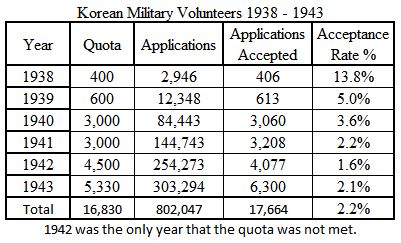

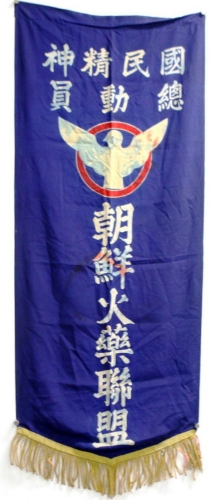
國民精神 總動員 朝鮮火藥聯盟
(국민정신 총동원 조선화약연맹)
“General Mobilization of National Spirit – Chosŏn Explosives Federation”
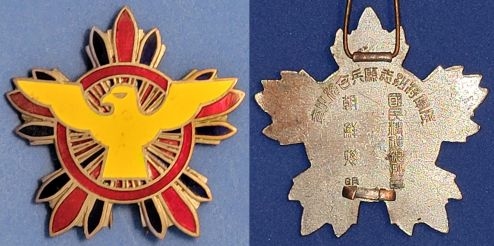
Army Special Volunteer Pass Badge
[Pass as in passed the exam and entered the volunteer training program]
Right Vertical line 國民精柮總動員 Mobilization of National Spirit
Left Vertical Line 朝鮮聯盟 Chosŏn Federation
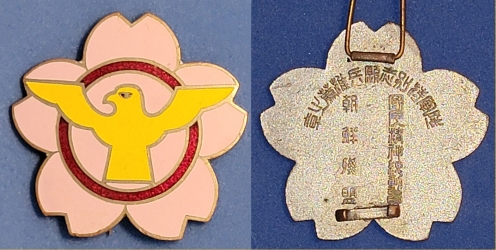
Army Special Support Soldier Reservation Branch
Right Vertical line 國民精神總動員 Mobilization of National Spirit
Left Vertical Line 朝鮮聯盟 Chosŏn Federation

for the Army special Support Soldier Reservation Branch
Photo source: 표창장 -[개화는 침략도구]
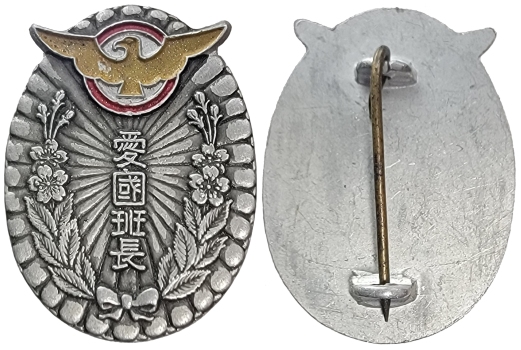
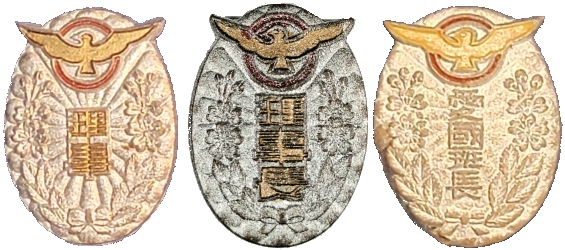
Two Character: 理事 (리사) Councilor.
Three Character Inscription 理事長 (리사장) Chairperson/Chairman.
Four Character: 愛國班長 (애국반장) Patriotic Group Leader.
The Chinese appear to be the first to use papier-mâché beginning about 200 AD, shortly after they invented paper.
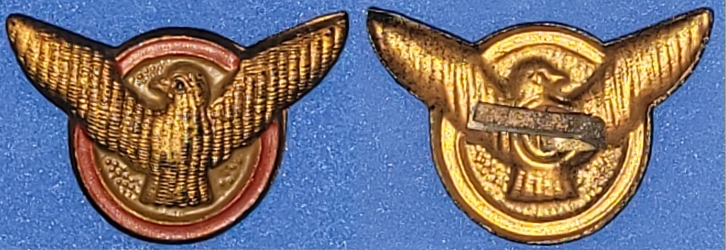

Government-General of Korea Official Gazette, Edict #95, February 26, 1938
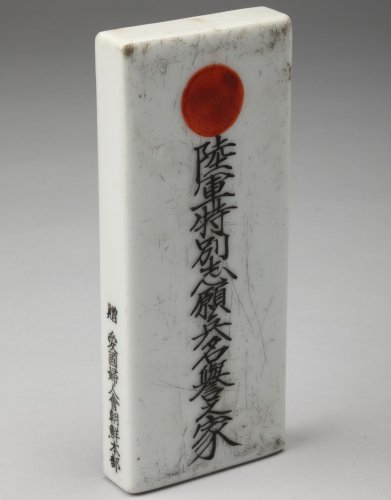
Front Inscription: 陸軍特別志願兵名譽之家 (육군특별지원병명예지가) Army Special Volunteer Home of Honor
There is a similar door plate without the sun symbol and with the 愛國班長 (애국반장) “Patriotic Group Leader” inscription.
Side Inscription: 贈 愛國婦人会朝鮮本部 (증 애국부인회조선본부)
Donated (by) Headquarters of the Chosŏn Patriotic Women’s Association. Ceramic, 16 × 7 cm
Photo source: Korean emuseum
Military Conscription
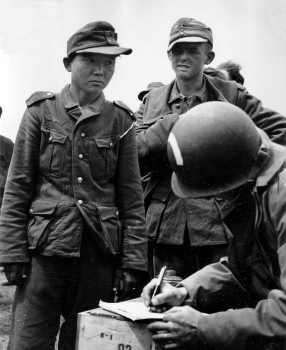
Japan’s attack on Pearl Harbor led to an increased demand for Korean manpower. On May 9, 1942, the Governor General of Korea (GGK) announced that beginning in December 1944, twenty-year-old Korean males would be conscripted into the Japanese military. On October 20, 1943, “Rules for Temporary Recruitment of Special Forces of the Army (Army No. 48)” 육군특별지원병 임시 채용규칙 (육군성령 제48호) was promulgated, and the Student Volunteer Service Act 학도지원병제 was implemented for college students and vocational school students who had previously been exempted from military service. It is believed that between the volunteer soldiers and the conscription systems, the total number of Korean men who served in the Japanese military was 213,719. Some 22,182 of these Korean soldiers were killed during WWII. Several sources state that because of the length of time needed to train recruits, few Koreans were actually sent to the war front before Japan’s surrender in August 1945. Even so, approx. 10.4% were killed in action.
There are various claims that Korean military conscripts were utilized as ‘bullet eaters’ or ‘bullet catchers’ 총알받이. They were placed in the front ranks of Japanese Banzai charges or in the rear ranks during strategic withdrawals/retreats. Supposedly without weapons or ammunition, since the Japanese did not trust them. Their sole duty was to catch a bullet meant for a Japanese soldier. Thousands of Korean laborers were sent to build fortifications for the Japanese, but were also trained to perform combat roles. There are reports that many Japanese did not feel that they could rely on Korean laborers to fight alongside them, and purportedly on some islands, killed their conscripted laborers when the Americans landed. Some of these claims have been proven spurious.
Between volunteers, military and labor conscripts, by the end of colonial rule, approximately 12% of Korea’s total population found themselves outside of Korea. For the young males between 20 and 25 years of age, the figure is probably 20 to 25%.3 At the end of the war, 5,400,000 Koreans were directly supporting the Japanese war effort in the civilian sector.
One of the most famous Korean conscript stories of World War II, is that of Yang Kyoung-jong 양경종. The story starts with his conscription into the Imperial Japanese Army. He was captured by the Soviet Red Army, and was sent to Russia’s western front to fight the Germans. He was subsequently captured by the German Wehrmacht and sent to France to help construct defenses at Normandy. Then, shortly after D-Day, he was captured by the U.S. Army, imprisoned in England, then transferred to a POW camp in the United States. Eventually, he became a U.S. citizen, moved to Illinois, got married, had children, and lived there until his death in 1992. He only told his story to his wife, and was never interviewed before his death, so the veracity of his exploits is widely debated. His story inspired the Korean movie “My Way”. In the 1994 book D-Day, June 6, 1944: The Climactic Battle of World War II, historian Stephen E. Ambrose wrote about an interview with Lieutenant Robert Brewer of the 506th Parachute Infantry Regiment, 101st Airborne Division, where Brewer recounted the capture of four Koreans in Wehrmacht uniforms.
For a far more exhaustive source of information on this subject, you should read the book “Fighting for the Enemy, Koreans in Japan’s War, 1937-1945”, by Brandon Palmer.4
Labor Conscription
At the onset of the Second Sino-Japanese War in 1937, Japan had not yet transitioned to a wartime economy, and many civilian sectors were outside of government control. In April 1938, Prime Minister Fumimaro Konoe 近衞 文麿5 pushed for the enactment of the National Mobilization Act 国家総動員法. Despite heavy domestic opposition, but with strong pressure from the military, the law was passed on March 24, 1938, and took effect on May 5th. The act declared a state of emergency, and allowed the central government to control all manpower, material, and the rationing of raw materials in the Japanese market. The National Service Draft Ordinance 国民徴用令 (Imperial Ordinance No. 451) also known as the National Requisition Ordinance was issued on July 8, 1939. This imperial edict went into effect on the July 15th, and was applied to Japan, Korea, Taiwan, and Sakhalin (in Korea, it did not go into effect until Oct. 1, 1939). This ordinance was a supplemental law also promulgated by Prime Minister Konoe. It gave the Minister of Health and Welfare the power to forcibly conscript personnel, to ensure an adequate supply of labor for strategic war industries. The only exceptions allowed were for cases of physical or mental disability. The Japanese often skew the numbers of conscripted laborers in their favor, but the same can be said of the Koreans. Some Korean workers were mobilized through a recruitment process that started in September 1939 and continued until January 1942. The Japanese list these workers as volunteers and not as conscripted workers, while the Koreans consider these workers to have been forced into the recruitment process. Many other Koreans were classified as émigrés, with Japanese claims that many of these individuals intended to be with family members already established in Japan. But regardless of their status, Koreans were severely limited in their choice of work. The Japanese government tried to direct that flow of Korean workers primarily to the coal and metal mines. Legally binding conscription began in Korea in September 1944, when the Japanese began using conscription warrants issued for specific individuals.
The conscription program was organized under the Ministry of Welfare, and at its peak, 1,600,000 men and women were conscripted, and 4,500,000 existing workers were reclassified as conscripted workers. Conscripted workers were not allowed to quit their jobs. Eighteen of the fifty articles within the law outlined penalties for violations. By the end of 1938, a year before the start of the wartime mobilization of Koreans, 800,000 Koreans were living in Japan. At the end of 1944 there were 1,911,409 Koreans in mainland Japan (excluding Karafuto Prefecture, present-day Sakhalin, Russia). Some sources claim that there were 6.16 million conscripted workers at the end of World War II, which included Japanese, Koreans, Chinese and possibly Military POWs. Some ordinances had long-term effects on the Japanese economy, resulting in policies such as lifetime employment, and the implementation of the “seniority wage” system. After the surrender of Japan, ending World War II, the National Mobilization Act and the National Service Draft Ordinance were abolished under Law #44, on December 20, 1945, by the American occupation authorities. The hardships endured by the conscripted Koreans did not end with liberation. After its defeat, Japan did not assist any Koreans wanting to return home.
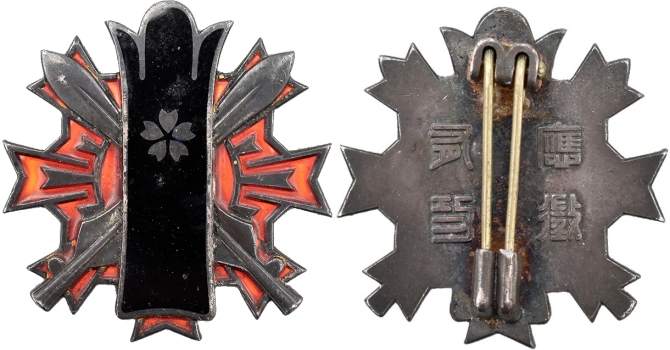
The Conscripted Workers Badge 応徴士徽章 (응징사휘장) was instituted on August 10, 1943, by the Ministry of Welfare. It was given to workers conscripted into wartime production service. In a factory consisting of regular employees as well as conscripted workers, only the latter were allowed to wear this insignia, which was to be worn on the left chest of the work uniform. Many Koreans refer to the wartime of mobilization based on the laws of the time as an inhumane form of “slave labor.” It is not surprising that many Koreans treat this insignia in a manner similar to the way that Jews treat the Star of David patches of Nazi Germany. However, it was worn by both Japanese and Koreans alike. This badge is often described as a Civilian Wound Badge. The badge has nothing to do with having been wounded nor being a reservist. It is in the same league as the Kamikaze headbands for female student factory workers.
On June 22, 1965, the “Treaty on Basic Relations Between the Republic of Korean and Japan” 한일기본조약, 韓日基本條約 was signed, and it was ratified on August 14 by the Korean National Assembly. This treaty normalized the diplomatic relations between South Korea and Japan. Japan paid South Korea 300 million dollars with no strings attached in accordance with the Agreement Concerning the Settlement of Problems in Regard to Property and Claims and Economic Cooperation. The treaty also gave $200 million to Korea in low-interest loans as a ‘reparation fee’. With this payment, both countries confirmed that all post-war claims, including those of Koreans who participated in wartime mobilization, had been settled “completely and finally.” Interestingly, enough, Japan initially had offered individual compensation, but the South Korean government rejected this. Of the $300 million, only about 2% went to the victims. The treaty has always been a source of derision within Korea. During the negotiations, the Park Chung-hee regime declared martial law to suppress dissenting voices. Korea did not disclose to the public that Japan’s personal compensation was to be used for infrastructure investment. This later created a rift in Korea-Japan relations due to differences of opinion on compensation claims. The subject of “War Time Conscripted Labor” is a hot potato topic between Japan and Korea. There has been a constant call from the South Korean public that Japan should compensate Korean individuals who suffered from Japanese colonial rule. Lawsuits have been filed in Korean Courts. In October 2018, the Supreme Court of Korea issued a ruling which ordered Mitsubishi Heavy to compensate the victims of forced labor. The company has not done so, with Japan arguing the matter was settled under the 1965 treaty. The Japanese Government has maintained that this ruling, along with the one made on Japan’s position in relations to the Korean comfort women (‘forced sexual slavery’) in January 2021, is a breach of the 1965 treaty. The U.N. Commission on Human Rights has advocated the South Korean government’s perspective by defining that the comfort women issue is a matter of human rights; the 1965 treaty only regulated property claims and not personal damages. North Korea claims that the Korea-Japan Basic Treaty is null and void as it was concluded between South Korea, a so-called “puppet” of the United States, and Japan, a “colonial power”. This primary opposition from the North is because the Korea-Japan Basic Treaty recognizes the Republic of Korea as the only legitimate government on the peninsula.
In March 2023, South Korean Foreign Minister Park Jin announced that the South Korean government would compensate those individuals who worked as conscripted wartime labor for the Japanese. The government plan is to take money from major South Korean companies that benefited from a 1965 reparations deal with Tokyo and use it to compensate the victims and their families. As a result of the announcement, there have been a number of South Korean protests.
On Jan. 22, 2008, the remains of 101 Korean military conscripts killed in nearly a dozen countries were returned to South Korea from Yutenji Temple in Tokyo. Another 1,034 sets of Korean bones are still stored at Yutenji Temple and are slated to be returned later in the year to South Korea and perhaps, subsequently, to North Korea, the ancestral home of 431 of the war dead. The remains belong mostly to military conscripts killed on overseas battlefields, but they include civilians (some of them women and children) who died in the accidental sinking of the Ukishima-maru transport ship soon after the war. In 2017/18, the remains of 101 Korean conscript laborers were returned to Korea. It is believed that another 200 sets of remains are currently in Japan.
The Aftermath of World War II
Following World War II, war crimes trials were held throughout Asia. Some 5,700 Class-B/C Japanese war criminals were charged with abusing and torturing civilians and war prisoners. Approximately 900 were executed. Among those prosecuted were 148 Koreans, of which 23 were executed. There are unconfirmed stories that during the war, the Japanese would routinely execute the entire family of any Korean soldier who failed to obey orders, which, if true, would help to explain, but not excuse, their behavior towards prisoners.
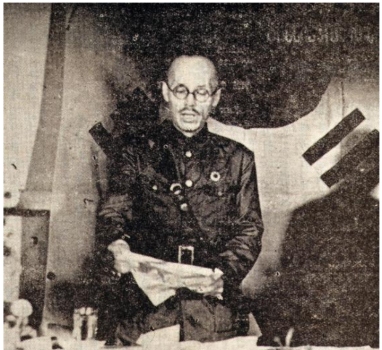
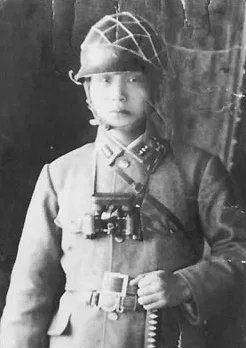
To the distress of many Koreans, there are officially 21,181 ethnic Koreans who died in the service of Japan’s military and regardless of whether they were volunteers or conscripts, they are enshrined as ‘Guardian Spirits’ 신 神 in the Yasukuni Shrine 靖国神社 or 靖國神社 in Chiyoda, Tokyo, Japan. The Yasukuni Shrine, is dedicated to the war dead since the start of the 1853 Meiji Restoration. Beginning in 1939, Koreans were required to take Japanese names under the Sōshi-kaimei Policy 創氏改名 (일본식 성명 강요) or face unfavorable conditions and harassment. Without supporting documents, ethnic Koreans who took Japanese names are not distinguishable from ethnic Japanese, so the number of enshrined ethnic Koreans is undoubtedly higher.6 Also enshrined are all the convicted and executed Class A, B & C War Criminals.7
Many Koreans, serving in the Manchukuo army, simply disappeared at the end of World War II. In August 1945, Manchukuo was destroyed by the advance of the Soviet army. At the time, many pro-Japanese collaborators in Manchukuo were either executed by people’s courts or taken into exile in the Soviet Union. Many of those, who were able to stay alive and return to Korea, simply created new identities to hide their pro-Japanese past.
At the end of World War II, a number of former Japanese Army officers had successful careers in post-colonial, South Korea. This would include Park Chung-hee 박정희 (朴正熙) (Japanese name Takagi Masao 고목정웅, 高木正雄), who became President of South Korea from 1961 to 1979, Chung Il-kwon (정일권, 丁一權), who became the prime minister of Korea from 1964 to 1970, and General Paik Sun-yup 백선엽 (白善燁). All ten of the original Chiefs of Staff of the South Korean Army were graduated from the Imperial Japanese Army Academies.
Yi Cheong-cheon 지청천 (池靑天) was a 1914 graduate of the Imperial Japanese Army Academy. In 1919, he defected to the Korean guerrilla forces fighting in China against the Japanese. He brought with him knowledge of Japan’s modern military techniques. He became the commander-in-chief of the Korean Liberation Army (KLA) 한국광복군 (韓國光復軍) when it was established on September 17, 1940.8 The KLA was the armed forces of the Provisional Government of the Republic of Korea. Yi Cheong-cheon was a friend and former classmate of Japanese Lieutenant General Hong Sa-ik 홍사익 (洪思翊) and tried to get him to defect to the Korean Liberation Army. Hong Sa-ik remained in the Japanese Imperial Army and was executed in 1945 for war crimes. During the war, Yi Cheong-cheon used several aliases to protect his family, which was trapped in Korea. Hong Sa-ik was known to have funneled money to Yi Cheong-cheon’s family in Korea before and during World War II. (The Korean Government under Syngman Rhee felt that the sins of Hong Sa-ik are inheritable and persecuted his son and daughter. They fled the country and moved to the United States.) Following Korea’s liberation at the end of World War II, Yi Cheong-cheon served as a member of the South Korean National Assembly. In 1962, he was posthumously honored with the Third Class of the Korean Order of National Foundation.
The Republic of Korea was officially established on August 15, 1948, exactly three years to the day after the Japanese surrender which ended WWII. South Korean Independence Day is also celebrated on August 15th.
Footnotes:
- Seppuku 切腹 refers to the traditional “ritual” of committing suicide by cutting the stomach open, while Harakiri 腹切り refers to the action of cutting the stomach open. The word Harakiri is not generally used in Japan.
- Published in “The Official Gazette of the Governor-General of Chosŏn” on February 26, 1938, and amended on October 16, 1944, enforcement began on April 3.
- Robert Repetto, Tai Hwan Kwon, Son-ung Kim, Dae Young Kim, John E. Solboda, and Peter J. Donaldson, Economic Development, Population Policy, and Demographic Transition in the Republic of Korea (Cambridge, Mass. and London: Harvard University Press, 1981), 44-6,48.
- University of Washington Press, 2023
- At the start of the Allied occupation of Japan, he served in the cabinet of Prince Naruhiko Higashikuni. After being suspected of war crimes, Konoe committed suicide in December 1945 by ingesting potassium cyanide.
- After the liberation of Korea from Japanese rule, the Name Restoration Order was issued on October 23, 1946, by the United States Army Military Government in Korea (USAMGIK), enabling Koreans to restore their Korean names if they wished to.
- Class B & C executed war criminals were enshrined in April 1959 and Class A executed war criminals were enshrined on Oct. 17, 1978.
- Also known as the Korean Independence Army 한국독립군 (韓國獨立軍).
